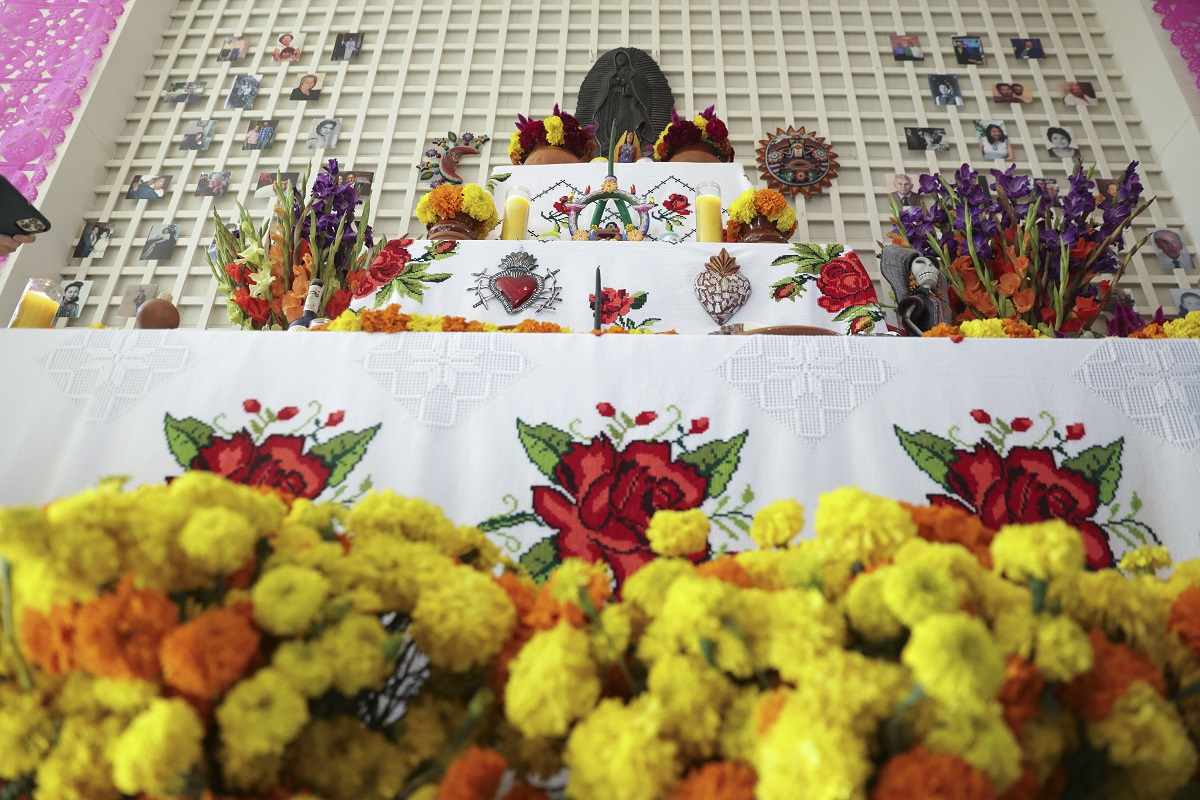
An ofrenda, or offering, at a Day of the Dead event at the White House in 2022.
12:55 JST, November 2, 2023
Parents, great grandparents and a beloved dog, Indi.
These are among the loved ones readers told us they are remembering this year on Día de los Muertos, or Day of the Dead, which is celebrated throughout Mexico and much of the Americas on Nov. 1 and 2.
The holiday is a special blend of disparate cultural customs and has been growing in popularity in recent years, said Mathew Sandoval, a scholar at Arizona State University who studies the holiday. Celebrations often incorporate Indigenous pre-Hispanic Mesoamerican spirituality, European Catholicism and African ceremonial traditions, said Sandoval.
“For many people, myself included, Día de los Muertos is an opportunity for us to honor our ancestors, meaning people deep within our ancestry, not just those we know who have died,” said Sandoval.
“They’re the links that give me my sense of Latino pride, Chicano pride, my sense of self, my sense of identity, my sense of culture.”
How it’s celebrated can vary greatly. In Mexico, an ofrenda – typically a display of pictures of the deceased and a special offering, such as candy, on a fireplace mantel – is common. (In 2021, the White House created its first ofrenda.) In Guatemala, many celebrate by making kites that they fly to reach closer to those who have passed, Sandoval said.
Below, read some of the ways that Washington Post readers are celebrating Día de los Muertos. Responses were edited for clarity and consistency.
Kristina M. Best-Ramos, 32, Boston
“For work, I am a therapist and also facilitate a ‘Creative Coping’ therapy group where we do art and talk about subjects relating to art.
This year, to prepare for Día de los Muertos, our group made our own altars. We used the traditional ‘garb’ that most altars include: the bright designs, butterflies, candles, marigolds, stones, etc. We used boxes as the actual altar as a cost-effective and easy way for clients to transport them home.
Even though many of the clients did not identify as Latinx themselves, myself and my co-facilitator do, and we wanted to make sure we could educate others on this. This was especially important because many/almost all of our clients have significant grief and recovery/grief often come up in group.
We learned the history of altars, we spoke about loss and celebrated those we included in our altar. It was wonderful, and life-changing to hear everyone’s stories.”
Natalie Moreno, 36, Seattle
“For the first time, I have made an ofrenda with my roommates to honor our families. We decorated it with picados, copal, candles, cempasúchiles, and photos.”
Brenda Coronel Steele, 34, Dallas
“I set up an ofrenda in my home honoring loved ones that have passed on. We share funny stories about our friends and family, and remember their favorite foods, favorite things to do, and their passions.
We honor all of our loved ones, but we have an unconditional love for our dog Indi. She’s been gone for two years now but the grief has been especially difficult to manage. We are finally able to be joyful in celebrating her spirit and welcome her with so many treats.”
Andrea Melear, 19, Minneapolis
“We are honoring my great grandparents and step-grandparents.
We always put up an altar with pictures of all our family members including pets. We fill it with cempasúchiles and candles, and all the foods they loved. We prepare sopa de fideos [a noodle soup] and a bottle of coke for my great-grandfather every year.”
Maria Gabriela Ayala, 33, Chicago
“Indigenous people from the highlands in Ecuador honored their ancestors by drinking ‘colada morada,’ a fruity purple maize beverage that represents the journey from life to death.
During October and up to early November, we celebrate by drinking colada morada accompanied by ‘guaguas de pan’ or baby-shaped bread that we decorate with our friends and family. It’s one of my favorite times of the year, and since moving to the U.S., I always try to have it.
I decorated [these guaguas] with my mom when she visited last year. She made the bread from scratch and filled it with jam or chocolate and I decorated them with a Halloween theme. Many years ago, I decorated them with a Mexican Day of the Dead theme.”
Lilia Figueroa, 35, Milwaukee
“This year I’m honoring my father and grandmother.
I helped build an altar at work with other co-workers. It was a way to be able to connect with each other regardless of our racial or cultural differences – we all have experienced loss.
Camila Chicaiza, 22, Ann Arbor, Mich.
“We do bread in the shape of a baby (head and body) and decorate it with frosting. We eat this with colada morada.
I have never really read anything about Ecuador being featured for its Día de los Muertos tradition.”
Andrew Lorusso, 28, Somerville, Mass.
“I honor my grandfather and grandmother, aunts, and uncles, whom I have lost throughout the years. I make sure to add new faces every year, but everyone meant something to me.
I celebrate by creating a small ofrenda in my apartment – it’s not very big.
On the table I have small decorations that me and my partner create. We create a new decoration once a year. I place the marigolds I grew in my balcony garden during the summer throughout the table. And I make sure to create at least one dish, usually sopita and a main dish. Then I add drinks all enjoyed, and fruits are scattered throughout. On the day, I make sure to sprinkle marigold petals leading from the door to my ofrenda.”
Sophia Rodriguez-Bell, 20, Berkeley, Calif.
“My grandma. She passed in September 2022, so this is our second year celebrating her.
I’m fourth- or fifth-generation Chicana, and the first mixed (i.e., half white) person in my part of the family.
We never celebrated Día de los Muertos until my grandma passed. I remember reading a children’s book as a kid about the holiday, but it was never something we celebrated.
After my grandma passed, the holiday felt more real, more important.
I do wonder if my celebration is more performative than genuine. Am I properly celebrating? Really, genuinely? Or am I trying to be more Chicana than I am?
My grandpa has a little ofrenda set up for grandma. He buys her flowers every week and leaves her the candy bars she loves. Now that we’re coming up on Día de Muertos, he will bring her cempasúchil.
I’m studying abroad this year, so I know she won’t be able to find me. I’ll use an electronic candle and put it in the window, and I’ll drink a lot of Mexican hot chocolate. (Sadly I can’t source any pan de muerto here!)
Still, I’m happy. I want her to come home to my grandpa. I want them to have another dinner together.
José Antonio Rico, 52, Chicago
“I have an altar that we maintain with flowers, copal and water year around.
During Día de los Muertos, we clean up the altar, add pictures of those that transitioned and add more food, mezcal and flowers.
In Chicago, we have huge public celebrations, exhibits, parades and public altars with music and food. Our traditions are strong here thanks to the culture workers and regular migration of people.
I keep my ancestors near me by sharing a story or lesson from one of the ancestors in the altar and toast them with a mezcal.
We have not celebrated lately because my parents are immunocompromised, so we join the public celebrations.
This year we are going to honor a teacher named Rigo Padilla-Pérez, who recently passed from cancer. Rigo was a leader in fighting for immigrant rights, especially for students, and helped organized a Dreamer scholarship at his school, Solorio Academy High School in Chicago. He will continue to be an inspiration to so many for his commitment to immigrant rights and human dignity.”
"News Services" POPULAR ARTICLE
-

American Playwright Jeremy O. Harris Arrested in Japan on Alleged Drug Smuggling
-

Japan’s Nikkei Stock Average as JGB Yields, Yen Rise on Rate-Hike Bets
-

Japan’s Nikkei Stock Average Licks Wounds after Selloff Sparked by BOJ Hike Bets (UPDATE 1)
-

Japanese Bond Yields Zoom, Stocks Slide as Rate Hike Looms
-

Japan’s Nikkei Stock Average Buoyed by Stable Yen; SoftBank’s Slide Caps Gains (UPDATE 1)
JN ACCESS RANKING
-

Keidanren Chairman Yoshinobu Tsutsui Visits Kashiwazaki-Kariwa Nuclear Power Plant; Inspects New Emergency Safety System
-

Imports of Rare Earths from China Facing Delays, May Be Caused by Deterioration of Japan-China Relations
-

University of Tokyo Professor Discusses Japanese Economic Security in Interview Ahead of Forum
-

Japan Pulls out of Vietnam Nuclear Project, Complicating Hanoi’s Power Plans
-

Govt Aims to Expand NISA Program Lineup, Abolish Age Restriction

























